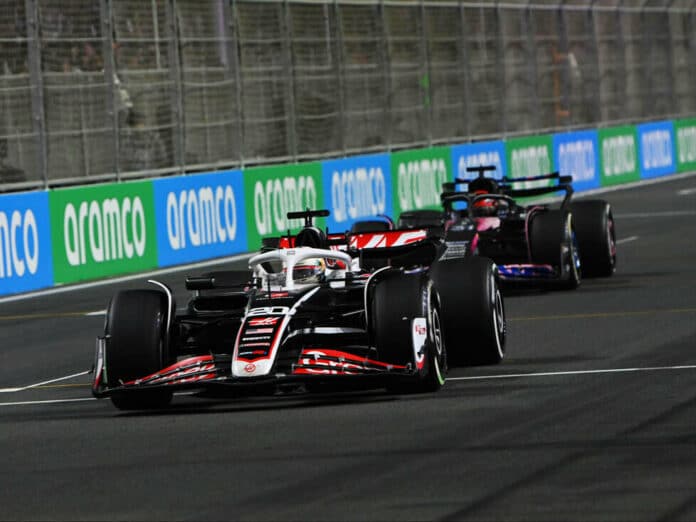Haas driver Kevin Magnussen caused hair-raising for the rest of the midfield teams at the Formula 1 race in Saudi Arabia: What the data says
The Red Bull winning streak entered the next round with Max Verstappen’s ninth consecutive triumph in Saudi Arabia. But what does the team data tell us? Our technology partner PACETEQ has provided us with the most important figures from the weekend, and it’s worth taking a closer look at the Haas team in particular
Looking first at the qualifying figures, the Red Bull RB20 was the fastest car on a fast lap. Max Verstappen secured pole position with a lead of 0.319 seconds over Ferrari driver Charles Leclerc, with Aston Martin’s Fernando Alonso (+0.374) also in the top battle
At the back of the field, Alpine once again brought up the rear (+2.0), but Racing Bulls were able to surprise with Yuki Tsunoda’s Q3 entry (+1.08). It is also worth looking at the pace of Ferrari rookie Oliver Bearman, who replaced regular driver Carlos Sainz due to illness. Although the 18-year-old Brit finished eleventh in Q2, his lap was only 0.530 seconds slower than that of team-mate Leclerc.
How good was Oliver Bearman’s race pace?
In the race, Red Bull’s lead increased as usual. If you adjust all the lap times for the different types of tires, the sprite effect and the track development, Verstappen was 0.18 seconds per lap faster than his team-mate Sergio Perez. Leclerc in the Ferrari was in third place, just over four tenths per lap behind.
With a deficit of 0.81 seconds per lap, Fernando Alonso in the Aston Martin was closer than in Bahrain, which, combined with the better strategy, earned the team fifth place. While McLaren (+0.59) also improved on Bahrain, Mercedes’ poor race pace (+0.71) will raise question marks at Brackley. The W15 had no chance in the fast corners, but was uncharacteristically fast on the straights.
Ferrari substitute driver Bearman, who finished seventh, was 0.61 seconds per lap down on his team-mate Leclerc. This meant that the actual Formula 2 Prema driver only had the ninth-best race pace, but the botched strategies of Lando Norris and Lewis Hamilton resulted in six points instead of two on their debut
Midfield blockade: How Magnussen helped Haas to the final point
A chance to score a point for the non-top teams in the midfield after Lance Stroll’s crash. Despite a poorer strategy due to not changing tires under the safety car in the early stages of the race, tenth place was secured by Nico Hülkenberg in the Haas. The German’s starting position looked anything but rosy after the missed pit stop opportunity.
He owed the final point above all to his team-mate Kevin Magnussen, who made the VF-24 as wide as possible. After two ten-second time penalties, the Dane had no chance of scoring points himself, which is why his team instructed him on the radio: “You have to drive a pace of 35.5” so that Hülkenberg can get onto the track ahead of the rest of the midfield cars after his stop
No sooner said than done. On lap 21, Magnussen was still 4.5 seconds behind Hülkenberg with a pit stop delta of 20 seconds. After successfully slowing down the pack behind him, Magnussen managed to widen the gap to his teammate to 22 seconds on lap 32, allowing Hülkenberg a free pit stop and therefore a points finish.
In terms of race pace, Magnussen was able to slow the midfield to a gap of over two seconds per lap to Max Verstappen. In comparison: Hülkenberg managed a deficit of 1.51 seconds per lap with a clear run.
Topspeeds: How Magnussen was able to keep the midfield behind him
The fact that the Dane was able to keep Yuki Tsunoda, Esteban Ocon, Alexander Albon and co. behind him for so long was down to the efficiency of the Haas VF-24. In qualifying, no car in the speed measurement was faster than the Haas with 338 km/h. Second place in this category was shared by Racing Bulls and Red Bull, albeit with a gap of five km/h.
The biggest problem child on the straights in Saudi Arabia was the McLaren team. In qualifying, they were eleven km/h behind Haas, and in the race they were even more than 15 km/h behind Racing Bulls on average without DRS. They were also twelve km/h slower than Mercedes, so it’s no wonder that Oscar Piastri couldn’t get past Lewis Hamilton, as there wasn’t much surplus left with additional DRS
Low tire wear: Was Pirelli too conservative?
With the early safety car after Lance Stroll’s accident, the race was already strategically over, as almost all drivers took the opportunity to switch to the hard tire. As this lasted for over 40 laps without any problems, the question arises as to whether Pirelli was perhaps too conservative with its choice of C2 to C4 tires.
So far, all races in Jeddah have been won with the medium-hard one-stop strategy, and the 2023 race was the one with the second-lowest tire wear of the season after Australia. This begs the question as to why Pirelli did not nominate the C5 tire to create more excitement?
Looking at the data, you can see that the soft C4 tire was not a good racing tire with little pace and relatively high tire wear. This was best seen with Lando Norris and Lewis Hamilton, who despite fresh soft tires had no chance against Bearman with old hard tires towards the end of the race
If Pirelli were to nominate the C5 in the future, the teams would at least be forced to use a poor tire – be it C4 or C5 – alongside the well-performing C3. Although the Grand Prix would strategically remain a one-stop race, the increased wear could result in larger tire deltas, making overtaking easier. Statistically speaking, Saudi Arabia is currently the sixth most difficult track to overtake on the entire Formula 1 calendar, despite three long DRS straights.







